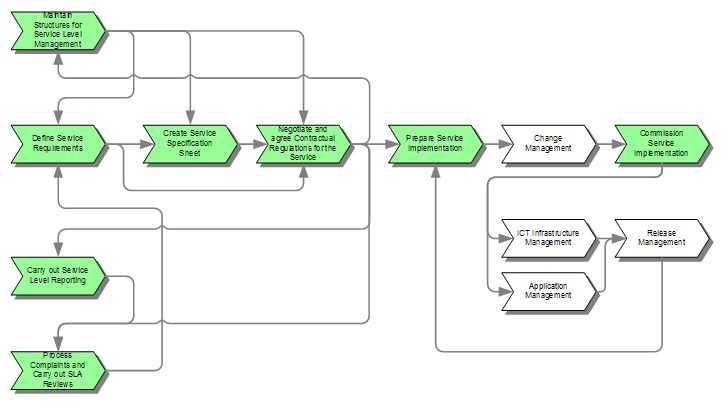Service Level Management - ITIL V2

ITIL Version: ITIL V2 → see also Service Level Management - ITIL V3
Process-Objective: Service Level Management has the tasks of maintaining the IT Organization's Service Catalogue and reaching binding agreements for internal and external Service Performances. At the interface with the client, Service Level Agreements are agreed. The Service Level Manager is responsible for the monitoring of the agreed quality parameters and where necessary resorts to counter-measures. The adequate provision of internal IT Services is secured via Operational Level Agreements and Underpinning Contracts (OLAs/ UCs).
Part of: Service Delivery
Process Owner: Service Level Manager
Sub-Processes

Maintain Structures for Service Level Management
- Process objective: The multitude of documents used within Service Level Management are to be adjusted in such a manner, that they correspond to the requirements of new or changed IT Services.
Define Service Requirements
- Process objective: Requirements from the client viewpoint with regards to a new or altered IT Service are to be documented and submitted to an initial evaluation, so that alternatives may be developed at an early stage for requirements which are not technically or economically feasible.
Create Service Specification Sheet
- Process objective: The requirements of a new or altered IT Service are described in more detail, and specifications are drawn up as to how the Service is created from an IT viewpoint and how the invoicing takes place.
Negotiate and agree Contractual Regulations for the Service
- Process objective: Finalization of binding agreements to an IT Service between the IT Organization and the client-side, a well as ensuring sufficient Service Levels with internal and external Service providers, which support the provision of the Service.
Prepare Service Implementation
- Process objective: Identification of preconditions, which must be established for the implementation of the new or altered Service, so that a corresponding Change Request may be compiled.
Commission Service Implementation
- Process objective: After clearance of the Change, the implementation of the IT Service is to be planned in further detail; the Service Level Manager subsequently commissions the technical experts in Application or Infrastructure Management to start the implementation.
Carry out Service Level Reporting
- Process objective: It is to be given account of the attained Service quality as well as potential counter-measures for the correction of infringements to the agreed Service Levels.
Process Complaints and Carry out SLA Reviews
- Process objective: Investigation of the agreed Service Levels, in order to ensure that the SLAs are still adequate for client requirements; processing of complaints and where necessary, assume corrective measures.
Involved Roles
- Capacity Manager
- Client (Contract Partner): In the first instance the Client is the opposite number of the Service Level Manager during the negotiation of Service Level Agreements. He is therefore responsible for the fact that the defined Service Levels are sufficient for the fulfillment of business objectives, and that the charges estimated for this purpose are justified from the Business perspective.
- Financial Manager
- IT Service Continuity Manager
- Service Level Manager: In ITIL V2 the Service Level Manager has the task of caring for the IT Organization's Service Catalogue and the exact description of the requirements of quality and quantity of the IT Services. Service Level Agreements (SLAs) are agreed upon at the interface with the client. The Service Level Manager is responsible for the monitoring of the agreed quality parameters and if necessary introduces counteractive measures.
Related Checklists and KPIs
Checklists
- Checklist Service Level Agreement (SLA)
- Checklist Operational Level Agreement (OLA)
- More Service Level Management templates ...






